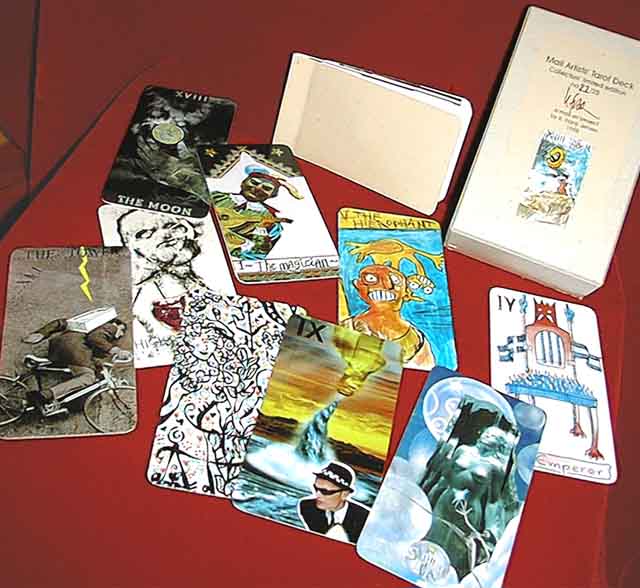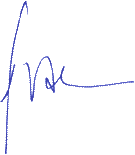About K. Frank Jensen
| |
PrefaceFor four years (1993-96) I organised an open mail art project called The Mail Artists’ Tarot. This project was described in four fully illustrated documentary booklets distributed to the contributors and other interested parties. After four years a review of the project was appropriate. Meanwhile, I had gained experience from two quite different types of mail art project, one called Mail Artists’ Trunk, where a limited number of artists were invited to decorate a cardboard template fitting into the small compartments of a trunk, made for another purpose, the other project being Mail Artists’ Lenormand Deck, a modern version of the traditional cartomancy deck. The documentation of this project also took the form of a card deck. The concepts for these two projects were combined in Mail Artists’ Tarot Deck 1998. |
When starting the Mail Artists' Tarot-project, the end result in mind was the production of a so-called set of "tarot majors", a new artistic interpretation of the 22 allegorical images which, since the time of the Italian Renaissance, have constituted the most interesting part of the 78 tarot card deck. The 22 images have, during centuries, attracted hundreds of artists, and "tarot majors" in all possible artistic styles from elaborate Renaissance art to modernistic and non-figurative art came to light. Heavy cardboard cut to the exact size of the final cards was used for the templates which were sent with the invitations for the project. Each template carried the name of the respective card the artist was to contribute. The use of heavy templates was due to experiences I had gained from the Lenormand-project, where incoming photocopied templates, deviating from the original measures, made trimming the final decks awkward. |
 | |
The selection of artistsI could have sent one template to 22 artists each, or two templates each to 11 artists. However, I wanted to expand the number of artists - there were so many more I would have liked to invite to join the project, but somewhere I had to set the limit. The templates, labelled with the assigned titles of the respective cards, were mailed in three rounds, allowing each artist four weeks from receipt 'til return of the works. During three rounds about 40 artists were invited, a few did not want to contribute, some others had moved address so the templates didn’t reach them. One artist sent his contributions so late after his 4 weeks deadline, that the defined cards were long ago transferred to others. After about four months I ended up with 66 contributions, three of each of the 22 cards, made by 33 artists from all over the world. |
My original plan was to make a deck similar to the Mail Artist’s Lenormand deck - laminated black and white photocopies - except this time it would coloured. I was, however, not entirely satisfied with the lamination solution, and wanted to avoid the glossy surface of the lamination, and yet make sturdy sets of usable cards. Experimenting with different methods of mounting, I finally discovered a hot mounting method, which, however, demanded investment in a laminator with hot rollers (instead of just a heating element). The cards were colour-copied on 160 grams paper, four on a sheet, and the copier was adjusted so they received an extra silicon oil covering during copying. When finished, the sheets were hot mounted, using a special hot mounting foil, on black Chromolux cardboard, trimmed to exact size and corners rounded, one by one, using a special thong. Beware, however, this method is extraordinarily time consuming! |
The documentationAs documentation for her/his partaking in the project each participant received a set of 22 cards including one of her/his own two contributions. The second card designed by the respective contributor was additionally included in the set also. The 22 cards were collated at random from the 66 available, only securing, of course, that there is one of each of the 22 titles included, and that there is not more than one card by the same artist. Using this method actually means that none of the decks in this "artists' edition" are exactly the same. To allow each contributor to see the entire range of the 66 cards, the accompanying booklet rendered all 66 cards in colour. 
K. Frank Jensen | |

By Simon Wintle
Member since February 01, 1996
I am the founder of The World of Playing Cards (est. 1996), a website dedicated to the history, artistry and cultural significance of playing cards and tarot. Over the years I have researched various areas of the subject, acquired and traded collections and contributed as a committee member of the IPCS and graphics editor of The Playing-Card journal. Having lived in Chile, England, Wales, and now Spain, these experiences have shaped my work and passion for playing cards. Amongst my achievements is producing a limited-edition replica of a 17th-century English pack using woodblocks and stencils—a labour of love. Today, the World of Playing Cards is a global collaborative project, with my son Adam serving as the technical driving force behind its development. His innovative efforts have helped shape the site into the thriving hub it is today. You are warmly invited to become a contributor and share your enthusiasm.
Related Articles

Panto
Panto card game designed by Neville Main and published by Pepys Games, 1956.

Gilbert & Sullivan Cards
“Gilbert & Sullivan” hand-made Savoy Operas pack designed and created by Rex Pitts.

Alison McDonald
Artwork for The Watersprite Tarot© designed and painted by Alison McDonald.

David James Binns
Hand-made “Tudor Playing Cards” by David James Binns, age 12.

Production Methods for Small Scale Editions
Some alternative approaches to producing small, hand-made editions of playing cards

Welcome to ‘On The Cards’
A Gallery of Playing Card Artists and Designers

Cats, Cakes, Clothes and Cups
Dianne Longley is a print artist who produces books and folios as well as intaglio and relief prints...

About Witta Jensen
WITTA JENSEN… on the cards.

About Karl Gerich (1956-2016)
About Karl Alexander Gerich, 23rd April 1956 — 4th January 2016

Jason Ennis Tarot Cards
Jason Ennis was a self trained artist interested in man's nature, his powers and abilities.

John Newman’s Colour Cards
John Newman’s Colour Cards

Teddy Bear playing cards & artwork
Teddy Bear playing cards & artwork, 1996.

About Peter Wood
Peter Wood is a UK based artist.

Hidden Mickeys
“HiddenMickeys” by Peter Wood
Most Popular
Our top articles from the past 28 days


 K Frank Jensen on the cards…
K Frank Jensen on the cards…
